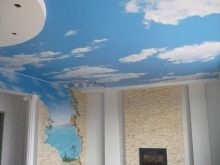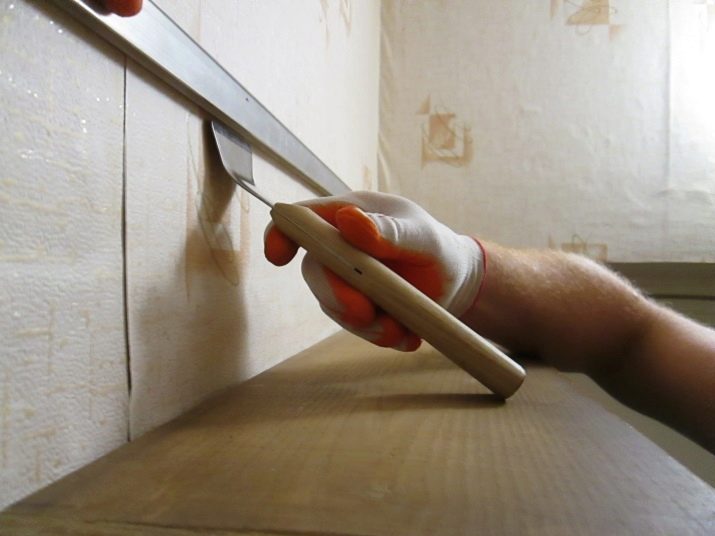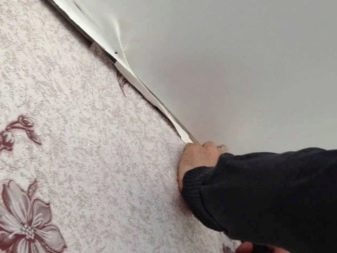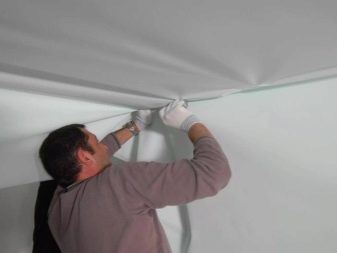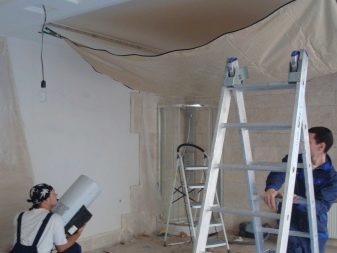How to independently remove the stretch ceiling?
Stretch ceiling is made of durable material, so it is reliable, designed for a long service life. Unfortunately, there are situations when it is necessary to remove it (the neighbors flooded the upper apartment, the electrical wiring failed, inadvertently damaged the ceiling). You need to know how to dismantle it step by step and install it yourself.
Process features
It is possible to dismantle the ceiling on their own. No need to contact specialists. First you need to deal with the type of damage. It may not always be necessary to completely dismantle the coating. Sometimes it is enough to soberly assess the situation, get by with a small expenditure of money and labor. The tension structure can again decorate the ceiling with preservation of its performance characteristics.
If the ceiling got a small gap far from the edge, you can disguise it with a decorative element or install an additional lamp.
With a large gap, it is permissible to hauling the web with the movement of the torn place closer to the edge, where it is easier to disguise it. But this option is possible only with vinyl film, which has a margin around the edges.
When using a fabric cloth material in stock does not happen. You can install the ceiling again if you follow some recommendations.
When the flood from the apartment above you must first get rid of the water. You can try to remove one of the lamps and pour water through the hole. Before returning the lights to the site, you must wait until the moisture is completely dry. It will take some time (up to two days). It is imperative to ventilate the room or include heaters in it.
Another way is to bend one of the corners of the ceiling and direct the water into the substituted bucket. The film on the reverse side will remain wet, but this is a matter of time. After drying the material and stretching the canvas will once again take on its previous appearance. With the initial low-quality tension, sagging can be corrected only by tightening.
The room may be subject to temperature changes. In this case, mold often develops.Therefore, the complete removal of the film for antiseptic processing is inevitable.
Training
The process of self-removal of the stretch ceiling is not as complicated as it may seem at first glance.
Instruments
Before starting work, the following tools should be at hand:
- pliers with long sponges;
- mounting spatula;
- mounting pegs;
- screwdriver;
- screwdrivers;
- special construction knife;
- heat gun (if the film is vinyl);
- step ladder.
Hand gloves are required. All sharp tools should be turned around the edges in order not to damage the canvas. Cutting tips can be glued with reinforced tape.
The room
The room must be freed from all objects that may interfere with work. Furniture will have to endure. It is imperative to remove fragile items and anything that does not tolerate heat. No sharp objects should remain in the room, so as not to damage the canvas.
The door to the room must be closed, plastic windows hang. If there is a gap between the door and the floor, it is necessary to close it tightly with rags. The room is sealed for heating with a heat gun.It is necessary to turn off the electricity not only in this room, but also in the whole apartment, turning off the machines on the counter. It is important to wait a few minutes to make sure the housing is completely disconnected.
It will be necessary to begin work on dismantling from warming up a room using a heat gun. When warming up the film softens. If the ceiling is flooded with water, sagging is better to maintain. Since it is not known how much water has flowed to the ceiling, it is better to bring several containers for its discharge.
If the defects are small, and the ceiling must be re-tightened, it is necessary to warm up the material to the edges for a more even stretching of the film and firm fixation on the baguette.
We clean the film cloth
To dismantle the work successfully, be sure to know:
- frame type;
- view of the ceiling.
Well, if at one time was drawn up a statement of work. It remains in the hands of the customer. Such information is always indicated in it. If there is none, it will be necessary to understand approximately (by eye). Tension fabric is used in two types: vinyl and polymer matter. You can determine the type of fastening system.
Fastening systems
Ceiling fixing technology determines the type of stretch and fasteners. When mounting, use one of the types of fastening systems.
Shtapikovaya
It is used for fabric ceilings and is quite expensive. It is a self-clamping device. The baguette is fastened to the wall or ceiling, and the edge of the canvas is inserted into it with an allowance of 5 to 7 cm. The flooring is slowly stretched over the entire area. They fix it with a bead which, under pressure of the fabric cloth itself, presses against the established profile.
Harpoon
This fastening system is preferred in that the web can be removed intact. This is due to the lack of clips during installation. Harpoon mount used in vinyl film form. When tensioning the ceiling, it first stretches under the influence of a heat gun, and then, around the edges, a hook or harpoon edging is applied to it. This type of attachment is made at the factory. Preliminary made at measurement of each room these experts transfer at the order of a cloth. To him and solder harpoon mount.
Without the help of a heat gun can not get to work. In cold form, the canvas does not stretch well and is easily torn. When installing or removing PVC film should be heated to a temperature of about 60-70 degrees Celsius. Otherwise, it will not become elastic.
Remove the vinyl film is completely necessary in cases where the cosmetic repair is impossible.
Inside the edging there is a wall leg with teeth. She fixes the hook. Such fixation is convenient when installing a stretch ceiling and removing it. The cover is removed without any damage. It can be used for re-assembly. The remaining space between the coating and the walls is sealed with a decorative plinth.
The plinth is removed when dismantling the ceiling first. Work begins at the corner of the room and continues along its length. Then the actions produced in width. The prepared metal spatula is inserted between the wall and the canvas, slightly bending down the moving part of the harpoon inside the slot of the baguette. Spatula hold pliers.
It remains only to remove the vinyl sheet from the baguette, gently pulling it towards you. Make it easy, because it is not clamped. Work with vinyl film is carried out in gloves. It warmed up, traces of dirt will remain from hands. If the seam is broken, you will have to replace the harpoon across the entire wall.
Cam
The system is called klipsovoy, it is applied with a vinyl film, a fabric impregnated with a polymer.It is the most popular technology currently used. It is cheaper than other species, it is easier and faster to mount. It is considered a seamless ceiling structure due to the small space from the ceiling during installation.
This mount is similar to self-tightening. Under tension, the canvas stretches to the edges (in the direction of the baguette) with a movable cam. They fixed the canvas. When dismantling this type of attachment, you will need a trowel. It is desirable to have a plastic tool for the preservation of the canvas.
Like the harpoon, the cam is pressed with a spatula. You need to start the process from the corner, where there is a free end of the film. If there is none, try to free any corner. The film is gently pulled out from under the mount. And so, step by step, it is necessary to move along the entire perimeter of the room until the entire film has been removed.
Wedge mount
Received the name from the wedge - fastening element. It is driven into the grooves of the baguette during installation. Cloth in advance chisel or other suitable tool is inserted under the baguette. Full clamping wedges contributes to the ceiling plinth, which is also a decorating element.
To remove the ceiling with a wedge mount is easiest. In this case, you do not need to pull the canvas out from under the baguette. When removing the baseboard, the wedge itself is weakened. It is necessary to pull off the fastener baguette with a spatula and pull out a wedge.
Cam and wedge mounting provides clamping ceiling material baguette. As a result, the coating is deformed, it is not always possible to mount it back. Therefore, you should consider whether you really need a complete removal of the material. It is possible to reuse PVC film using a staple or clip-on fastening system if there are spare centimeters of canvas under the ceiling. If it was not put on during installation, it is not always possible to pull the vinyl back. Need a full constriction.
Features remove the fabric web
Fabric ceilings provide for predominantly staple or clip mounting systems. They are more convenient for stretching and removing the fact that it does not require a strong heating of the room to soften the material. However, these options are more difficult due to the greater weight of the fabric in comparison with the film. Moreover, when it is fixed using self-clamps.And this leads to a complete removal of the coating (otherwise the baguette or bead may break).
If the mount is staple, when removing the material, first remove the decorative plinth, bend the profile, remove the bead and remove the released web. While this operation is underway, the ceiling is constantly heated by a stream of warm air from the included gun. This will help protect the fabric from the formation of fine wrinkles, sagging.
When removing the baguette, you must act with extreme caution to preserve its integrity. It may still be useful elsewhere.
The ceiling plinth is glued to the wall when the ceiling is properly installed. First, the fabric does not get dirty with glue. Secondly, when repairing the next time, it, like the ceiling itself, is not replaced, because it has a long service life. If the masters stuck a baguette to the ceiling when stretching the ceiling, additional difficulties arise during the removal.
Fabric ceilings installed with clip-on baguettes are removed completely. Partial withdrawal is impossible, it is not worth wasting energy. There is a danger of the web falling out of the installed clips. Fabric ceilings are preferable to the absence of seams, for this reason they are easier to dismantle. No need for special tools and complex hand manipulations. Work with the ceiling of the fabric starts from the middle. It is necessary to gradually move to the corners of the room.
Useful tips on the work
When dismantling the stretch ceiling on their own, observe Three basic simple rules:
- work without haste;
- take care and caution;
- whenever possible have an assistant.
Do not forget about the temperature in the room. It must be maintained for the elasticity of the film. It is necessary to observe the sequence of work when removing fasteners. Pliers need to keep only the harpoon, you can not touch them to the canvas. Do not pull the cover when pulling out with force. It should be done very carefully.
If an electric heat gun is used in the work, for its operation it is necessary to initially consider a separate connection option. Most likely you will have to agree in advance with one of your neighbors about connecting to their outlet.
Contact with water (when flooded) can strike with current if only one phase is switched off.
An easy dismantling process is possible when using high-quality materials during the installation of the stretch ceiling and the performance of work by craftsmen.They will treat the installation professionally, if necessary, dismantling the fabric is suitable for reuse. Now the work on removing the stretch ceiling with their own hands will not cause trouble. The more careful the work, the more expensive elements of the structure will be retained for recycling. Instructions for dismantling is not complicated at all.
Instructions for removing the stretch ceiling, see the next video.



